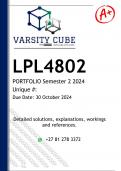LPL4802
PORTFOLIO Semester 2 2024
Unique #:
Due Date: 30 October 2024
Detailed solutions, explanations, workings
and references.
+27 81 278 3372
, QUESTION 1 (ESSAY) NATURE AND ASSESSMENT OF NON-PATRIMONIAL
LOSS AND DAMAGES FOR PATRIMONIAL LOSS
1.1.
To succeed in a claim for emotional shock, or psychiatric injury, under South
African law, certain elements must be proven by the plaintiff. These elements are
closely linked to the general principles of delictual liability and have been shaped
by both common law and judicial precedent. A delict is a civil wrong that results in
harm or loss, and to claim successfully, all five elements of a delict must be
present: conduct, wrongfulness, fault, causation, and harm or loss. In the context
of emotional shock, these elements are particularly scrutinized. Below is a
discussion of what the plaintiff must prove to succeed in such a claim, with
reference to the case of Komape and Others v Minister of Basic Education and
Others [2020 (2) SA 347 (SCA)] and other relevant authorities.
1. Conduct
The first requirement is the defendant’s conduct. This refers to any act or
omission by the defendant that causes the harm suffered by the plaintiff. In cases
of emotional shock, the plaintiff must demonstrate that the defendant’s conduct
was the cause of their emotional distress. This can occur when the plaintiff
witnesses or hears of a distressing event, such as the death or injury of a close
relative. In the Komape case, the plaintiffs witnessed the aftermath of their son’s
tragic death when he drowned in a pit latrine at school. The school's and
government authorities' failure to ensure proper and safe sanitation facilities
amounted to the harmful conduct leading to the emotional shock suffered by the
plaintiffs(Reported case law).
2. Wrongfulness
Wrongfulness in delict refers to the breach of a legal duty not to cause harm. In
cases of emotional shock, the plaintiff must show that the defendant’s conduct
was wrongful, i.e., that the conduct was unreasonable and violated a duty of care.
The duty of care is often determined by the foreseeability of harm. In the Komape
case, the court had to consider whether the school authorities had a legal duty to
ensure the safety of their students, particularly in relation to the state of the pit
Varsity Cube 2024 +27 81 278 3372
, latrines. Given that the dangerous condition of the toilets was well known and that
no action was taken to remedy it, the court found that the authorities’ failure to act
was wrongful. The harm suffered by the plaintiffs was reasonably foreseeable, as
a young child falling into a pit latrine was an obvious risk under the circumstances
(Reported case law).
3. Fault (Negligence or Intention)
To establish fault, the plaintiff must prove that the defendant acted either
negligently or with intent (dolus). In most cases of emotional shock, negligence is
the form of fault that must be proven. Negligence occurs when the defendant fails
to exercise the level of care that a reasonable person would in similar
circumstances. The test for negligence includes determining whether a
reasonable person in the defendant’s position would have foreseen the likelihood
of harm and taken steps to prevent it.
In Komape, the court found that the education authorities were negligent in their
failure to address the hazardous conditions of the pit latrines despite numerous
warnings and complaints. The foreseeability of harm, particularly to young
children, was clear, and the failure to remedy the situation amounted to
negligence. The authorities' inaction directly contributed to the circumstances that
led to Michael Komape’s death and the subsequent emotional shock suffered by
his family(Reported case law)(Reported case law).
4. Causation
The plaintiff must also prove causation, which involves demonstrating a link
between the defendant’s conduct and the harm suffered by the plaintiff. There are
two types of causation: factual causation and legal causation. Factual causation
refers to whether the defendant’s conduct factually caused the harm, which is
typically determined by the "but-for" test (i.e., but for the defendant’s conduct, the
harm would not have occurred). Legal causation deals with whether it is fair and
reasonable to hold the defendant liable for the harm caused.
In the Komape case, factual causation was established because the authorities'
failure to maintain the school’s sanitation facilities led directly to Michael’s death
and the resultant emotional shock experienced by his family. The court also
Varsity Cube 2024 +27 81 278 3372




